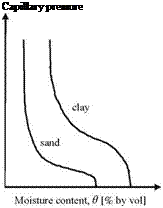The Soil Water Characteristic Curve (SWCC)
The soil water characteristic curve (SWCC) provides the relationship between the matric suction and water content for a given soil. In fact, calling the curve “characteristic” is something of a misnomer as the relationship is not solely a function of the soil type, but varies with (for example) temperature, pressure and pore water chemistry. A typical soil water characteristic curve for sand and clay can be seen in Fig. 2.9a.
 |
![The Soil Water Characteristic Curve (SWCC) Подпись: Capillary pressure Moisture content, 0 [% by vol]](/img/1312/image070_4.gif) |
Figure 2.9 shows clearly that, even at very high matric suctions (capillary pressures), all the water cannot be removed from the soil. The residual (or the irreducible) water content, usually denoted 0r (and in a similar way the irreducible water saturation, Srr) is the water content that is not removed in the soil even when a large amount of suction is applied.
Fig. 2.9 (a) Typical characteristic curves for coarse grained (gravel, sand) and fine grained soils (clay, silt). (b) Soil water characteristic curve showing drainage, wetting and scanning (intermediate) curves. The dotted line represents the irreducible (residual) water content
For most soils the soil water characteristic curve (SWCC) shows hysteresis. This means that the 5 – в (or the Ф – 0) relationship depends on the saturation history
as well as on the existing water content. Figure 2.9b shows the SWCC for drainage and wetting conditions. The upper curve corresponds to a soil sample that is initially saturated and is drained by increasing the matric suction (capillary pressure), hence the drainage curve. The lower curve is called the wetting curve and gives the rewetting of the soils with corresponding decrease in capillary pressure. If a wetting or a drainage process is stopped between the two endpoints and a reverse process is starting the scanning curves (indicated by arrows) are followed.






Leave a reply